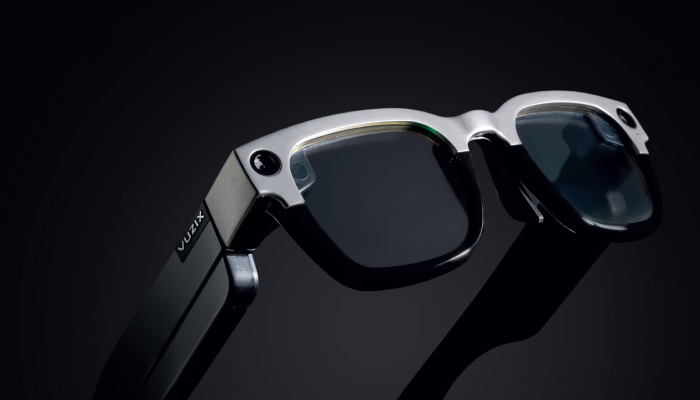Smart Glasses: Upgrading the Workforce
Understanding the role of augmented reality eyewear in the workplace
Many mainstream companies are betting on the potential of smart glasses to catch the consumer’s eye and change daily experience as we know it – and for good reason. Just as Ivan Sutherland envisioned it back in the 1960s, these devices have the potential to superimpose digital elements onto the real-world environment and reinvent our relationship with content.
The current range of available models have veered towards entertainment and interaction-centric applications, much like a smartphone. But there is growing interest in the potential of augmented reality to impact workforce-heavy industries through real-time instruction and data display.
Vuzix, founded in 1997 as an optics technology company, is a leading figure in this space, with five products currently available – the latest being the Vuzix Shield. We spoke with Paul Travers, Founder and CEO of Vuzix, to learn more about their work and collaboration with 3D printing company, Materialise.
What can you tell us about Vuzix Shield?
The Vuzix Shield is our latest pair of smart safety glasses designed for the connected workforce. It offers an advanced 3D binocular waveguide display system (monochrome green), and is seen as the next step from our M-Series model, with camera-based use cases and interaction through voice command and a touchpad. The Shield, too, offers a more natural viewing experience for the wearer, as it could be described as more “normal” looking when compared to our previous range of industrial smart glasses products. It also possesses AI-integrated features, such as directional voice recognition and language translation, which could make new consumer focused use cases possible – like supporting those suffering from hearing loss through real-time captioning.
Why do we need smart safety glasses?
Many people suggest the use of smart glasses will become ubiquitous across both industry and consumers, with such wearables ultimately replacing, to at least some degree, smartphones and smartwatches (which currently sell over one billion units annually). To meet this future, however, the foundation must be laid for the widespread adoption of AR across various industries. This is an area we hope to capitalize on in the safety sector. Of course, augmented reality is becoming more prevalent in our increasingly digitized workforce, and safety-rated glasses are essential in a broad range of industrial settings. I see them as a natural improvement to performance and safety.
What advantages does 3D-printed titanium offer?
We initially explored injection molding with carbon-filled and glass-filled plastics, but struggled to obtain sufficient rigidity despite multiple design iterations. For instance, connecting a cable to a battery in your pocket could exert enough torque on the glasses to cause a slight misalignment between the lenses, making the technology unusable. Finding the right weight, design, and form factor was critical, in this regard.
Together with Materialise’s post-processing, titanium parts achieve an accuracy within 0.1 mm and a high-quality finish adds an extra touch of luxury, meaning the frames not only function as intended – they also look great, too. Titanium allows the technology to be completely housed in the front of the frame without compromising functionality, meeting the precise tolerances. A 3D-printed titanium frame is also markedly stronger than plastic, which is crucial for smart glasses that may be repetitively worn and handled in a variety of customer scenarios.
How does Materialise’s 3D printing improve prototyping efficiency for smart glasses?
When developing a variety of shapes, styles, and sizes for smart glasses, extensive iteration is required. This was an area Materialise’s 3D printing capabilities facilitated very well. A cut is made, and something might not work or the design isn’t what was wanted, so another cut is made, then another — if this was being done with injection molded parts, it would be incredibly expensive and time-consuming because of the tooling changes and the like. Instead, our process allowed for lightning-fast prototyping. Then, after settling on the final design, we can move on to production.
What can you tell us about your waveguide factory?
Vuzix is primarily an optics company specializing in the development and production of optical waveguides, which are essentially structures used to guide light. Our new factory is a manufacturing plant designed to increase build capacity, lower manufacturing costs, and advance waveguides using higher index materials, advanced glass substrates, and unique configurations. We have also introduced Incognito-enabled waveguides, which reduce forward eye glow when displays are active.
Now, we’re hoping to establish infrastructure to support the production of prescription-based waveguides, with plans for scaled production. The prescription lenses need to be finished, trimmed, and integrated with the smart glasses waveguides in a controlled environment. This process can utilize much of the existing industry infrastructure for high-volume prescription glasses, aiding most prescriptions – including bifocals and astigmatism. An Ophthalmic Advisory Board is providing strategic input and guidance on vision correction issues and product development.
The New Optometrist Newsletter
Permission Statement
By opting-in, you agree to receive email communications from The New Optometrist. You will stay up-to-date with optometry content, news, events and sponsors information.
You can view our privacy policy here
Most Popular
Sign up to The New Optometrist Updates
Permission Statement
By opting-in, you agree to receive email communications from The New Optometrist. You will stay up-to-date with optometry content, news, events and sponsors information.
You can view our privacy policy here
Sign up to The New Optometrist Updates
Permission Statement
By opting-in, you agree to receive email communications from The New Optometrist. You will stay up-to-date with optometry content, news, events and sponsors information.
You can view our privacy policy here







